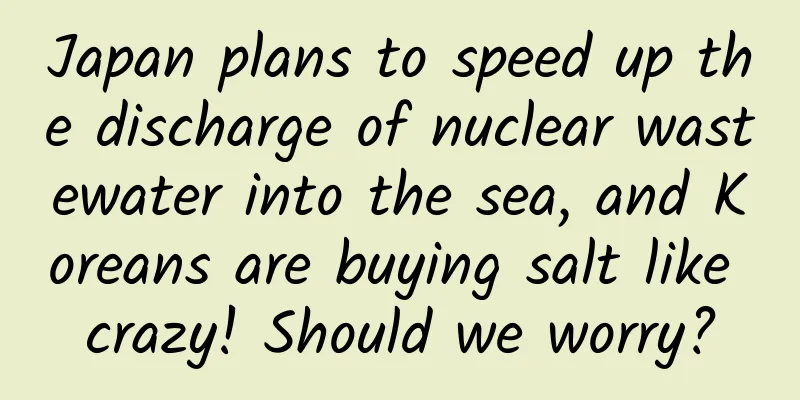Japan plans to speed up the discharge of nuclear wastewater into the sea, and Koreans are buying salt like crazy! Should we worry?

|
On July 4, the International Atomic Energy Agency (IAEA) released a comprehensive assessment report on the Fukushima nuclear power plant's nuclear wastewater discharge into the sea. The report claimed that Japan's nuclear wastewater discharge plan "complies with international safety standards", which aroused international doubts. Japanese media reported that the Japanese government is preparing to speed up the process of discharging nuclear wastewater from the Fukushima nuclear power plant into the sea based on the final report of the IAEA. ▲On June 14, 2023, local time, in Dunsan-dong, Daejeon, South Korea, there was a shortage of sea salt in supermarkets. (Source: Oriental IC) When the news of the upcoming dredging reached South Korea, local people began to frantically buy salt and seafood. South Koreans believed that after the seawater was polluted, some seafood would be seriously contaminated with radiation, including edible sea salt that people use every day. So, is it necessary for the public to worry about the pollution of sea salt? Will my country be affected and suffer from salt shortage? “The sea contains hundreds of tritium” is becoming a reality Japan's decision to discharge nuclear wastewater into the sea has attracted global attention and controversy. Although the Japanese government claims that the concentration of radioactive substances in the treated wastewater will be lower than international standards, many people are still concerned about the risks that the discharge of nuclear wastewater may cause to the marine environment and human health. A study in Science magazine showed that the nuclear waste water from Fukushima, Japan, contains a variety of radioactive components. The nuclear pollution components include cesium (Cs-131/133/137), strontium (Sr90) and iodine (I-131/135) and other radioactive elements, among which elements such as tritium are difficult to remove. ▲Storage tanks for nuclear wastewater in Fukushima, Japan. (Photo source: CCTV News) The Japanese government said that the nuclear wastewater discharged into the sea is safe and harmless to the human body, and a small amount of tritium does not affect health. When discussing the radionuclide radiation dose in the water, the Tokyo Electric Power Company (hereinafter referred to as "TEPCO") once described that an adult can "drink two liters a day for a year." On June 6, according to the Japan Broadcasting Association (NHK), TEPCO has injected about 6,000 tons of seawater into the basically completed sea discharge tunnel, and started a two-week trial operation of the equipment. However, on June 11, when experts from Pacific island countries suggested that Japan consume nuclear wastewater in the process of using concrete in infrastructure construction, the country rejected the proposal on the grounds that "nuclear wastewater may cause the evaporation of radioactive tritium, which is harmful to the human body." The contradictory statement once again caused concern from the outside world. On June 26, TEPCO announced that the submarine tunnel for discharging wastewater from the Fukushima Daiichi Nuclear Power Plant had been completed. Two days later, Japan's nuclear regulator, the Atomic Regulation Authority, began a comprehensive pre-use inspection of the nuclear wastewater discharge equipment, which ended on the 30th. In other words, the preliminary preparations for the discharge of nuclear wastewater into the sea are nearing completion. On July 4, the International Atomic Energy Agency said that Japan's plan to discharge nuclear wastewater into the sea complies with international safety standards. While this was condemned by the international community, it also accelerated the process of discharging nuclear wastewater from the Fukushima nuclear power plant into the sea. South Korean people have recently been frantically buying salt and seafood, demonstrating their fear of Japan's nuclear wastewater through practical actions. How does seawater become salt? Is it safe? 1 kg of seawater contains about 35 grams of salt. This salt is called sea salt, of which only 27 grams is table salt for seasoning. In addition to sodium chloride (called table salt), the salt in seawater also contains substances such as magnesium chloride. So where does the salt in the ocean come from? The salt in the ocean comes from the rocks that cover the earth. Raindrops fall on the rocks, and the rainwater dissolves certain substances contained in the rocks. This water (plus spring water) slowly turns into rivers and flows into the ocean. Sea salt is produced by introducing seawater into the salt pond on the beach, evaporating the water through sunlight, and then purifying it to make edible sea salt. It accounts for about 15%-20% of the total salt. The main sea salt producing areas in my country are Liaoning, Hebei, Tianjin, Shandong, Jiangsu and other places. In addition, Hainan, Guangdong and other places also produce some sea salt, usually called southern sea salt, with lower production. ▲Workers working in the sea salt crystallization pool (Photo source: Fujian Daily) In response to public concerns about the impact of seawater pollution on salt safety, a relevant person in charge of a certain Salt Administration stated that my country's salt production must undergo three rigorous testing and inspection processes at the primary, intermediate and advanced levels, and only after meeting the inspection standards will it enter the finished salt production stage; after the finished salt is produced, it must pass moisture and standard tests before it can be sold on the market, ensuring that each batch of salt enters the market safely. Experts remind the public not to panic about the impact of Fukushima nuclear wastewater. Although nuclear contaminated water may have a certain impact on the marine environment, treated salt is safe. Experts call on the public to remain calm and not blindly follow the trend to buy salt. In addition to sea salt, there are many other salts to choose from in my country Salt resources are widely distributed in nature. There are abundant salt in seawater, salt lakes, salt wells and salt mines. my country is the world's largest producer of raw salt. About 10 million tons of raw salt in my country is used to make table salt. In recent years, my country's annual salt production has stabilized at about 12 million tons. According to the source, in addition to sea salt, there are also well salt and lake salt. In fact, well salt is the main type of edible salt for the Chinese people. Well salt is made from rock salt or underground natural brine (excluding coastal underground brine), which accounts for about 70%-75% of the total salt. Surface water is injected into underground salt mines to dissolve rock salt ore to form saturated brine, which is then introduced into vacuum salt making equipment to evaporate the water and make salt. The main production areas of well salt are Sichuan, Hubei, Hunan, Shaanxi, Jiangsu, Henan and Jiangxi. (Picture from the Internet) Lake salt is salt mined from salt lakes or made from salt lake brine. It accounts for about 5%-10% of the total salt production, and is mainly produced in Qinghai, Xinjiang, Inner Mongolia and Gansu. In addition, according to the processing technology, it can be divided into ordinary table salt (including refined salt, crushed washing salt, sun-dried salt, etc.) and multi-variety table salt (including low sodium salt, reduced sodium salt, seasoning salt, special process salt, etc.), which play different uses in our lives. (This article is based on the website of the State Administration for Market Regulation, People's Daily Online, CCTV News, Kankan News, Southern Window, Science Principles, etc.) |
<<: What are the Wei, Jin, Southern and Northern Dynasties?
Recommend
Event Operations: 18 pages of secrets for explosive growth!
How can I successfully swipe the screen? The most...
Analysis of Taocaicai’s operating methods!
Recently, I have become addicted to shopping for ...
Analyst: iPhone will need a big price cut or redesign next year
Earlier this year, Wedbush Securities analyst Dan...
Which cloud computing company is better? Amazon vs. Microsoft
Last week, Amazon and Microsoft released their qu...
37 public account editing skills that new media people must know!
When creating content for a public account, there...
Does a moving hairline mean hair loss? Don’t panic, real hair loss has these characteristics...
Author: Tang Jiaoqing, attending physician of der...
Weaving, rapping, tilling the land...the "workers" in the cultural relics are also admirable!
Diligence is a traditional virtue of the Chinese ...
Why can't we see atoms with an optical microscope?
Through an optical microscope, we can see bacteri...
Respiratory diseases are coming in groups! Please remember the tips to avoid pitfalls when taking medicines
Autumn and winter are the peak seasons for respir...
In October 2023, China exported 736,000 cars to Russia, a year-on-year increase of 489%.
Recently, according to foreign media reports, Rus...
In the next 10 years, which Internet vertical fields are most suitable for entrepreneurship?
[[155596]] I heard that the Internet is full of g...
User growth operation: How to achieve explosive growth of products?
Due to the epidemic this year, many Internet comp...
How much does it cost to customize the Zaozhuang coupon mini program? Zaozhuang coupon applet customized price inquiry
How much does it cost to customize the Zaozhuang ...
6,000 worms in one snail! What kind of snail can eat so much?
Audit expert: Li Weiyang Well-known science write...
How to trigger user growth? Follow these 5 steps!
In the past, a brand’s advertising investment was...









